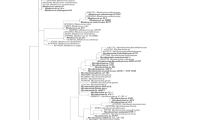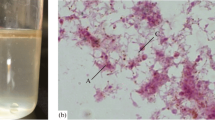Abstract
Thirty-six bacteria that degraded long-chain hydrocarbons were isolated from natural environments using long-chain hydrocarbons (waste car engine oil, base oil or the c-alkane fraction of base oil) as the sole carbon and energy source. A phylogenetic tree of the isolates constructed using their 16S rDNA sequences revealed that the isolates were divided into six genera plus one family (Acinetobacter, Rhodococcus, Gordonia, Pseudomonas, Ralstonia, Bacillus and Alcaligenaceae, respectively). Furthermore, most of the isolates (27 of 36) were classified into the genera Acinetobacter, Rhodococcus or Gordonia. The hydrocarbon-degradation similarity in each strain was confirmed by the 2,6-dichlorophenol indophenol (2,6-DCPIP) assay. Isolates belonging to the genus Acinetobacter degraded long-chain normal alkanes (n-alkanes) but did not degrade short-chain n-alkanes or cyclic alkanes (c-alkanes), while isolates belonging to the genera Rhodococcus and Gordonia degraded both long-chain n-alkanes and c-alkanes.

Similar content being viewed by others
References
Aislabie J, Saul DJ, Foght JM (2006) Bioremediation of hydrocarbon-contaminated polar soils. Extremophiles 10:171–179
Arenskötter M, Baumeister D, Berekka MM, Potter G, Kroppenstedt RM, Linos A, Steinbuchel A (2001) Taxonomic characterization of two rubber degrading bacteria belonging to the species Gordonia polyisoprenivorans and analysis of hyper variable regions of 16S rDNA sequenced. FEMS Microbiol Lett 205:277–282
Asperger O, Singh HD (1991) The biology of Acinetobacter. Plenum Press, New York, pp 323–350
Dua M, Johri AK, Singh A, Sethunathan N (2002) Biotechnology and bioremediation: successes and limitations. Appl Microbiol Biotechnol 59:143–152
Hanson KG, Desai JD, Desai AJ (1993) A rapid and simple screening technique for potential crude oil degrading microorganisms. Biotechnol Tech 7:745–748
Iwamoto T, Nasu M (2001) Current bioremediation practice and perspective. J Biosci Bioeng 92:1–8
Ko SH, Lebeault JM (1999) Effect of a mixed culture on co-oxidation during the degradation of saturated hydrocarbon mixture. J Appl Microbiol 87:72–79
Koma D, Hasumi F, Yamamoto E, Ohta T, Chung SY, Kubo M (2001) Biodegradation of long-chain n-paraffines from waste oil of car engine by Acinetobacter sp. J Biosci Bioeng 91:94–96
Koma D, Hasumi F, Chung SY, Kubo M (2003a) Biodegradation of n-alkylcyclohexanes by co-oxidation via multiple pathways in Acinetobacter sp. ODDK71. J Biosci Bioeng 95:641–644
Koma D, Sakashita Y, Kubota K, Fujii Y, Hasumi F, Chung SY, Kubo M (2003b) Degradation of car engine base oil by Rhodococcus sp. NDKK48 and Gordonia sp. NDKY76A. Biosci Biochem Bioeng 67:1590–1593
Koma D, Sakashita Y, Kubota K, Fujii Y, Hasumi F, Chung SY, Kubo M (2005) Degradation pathways of cyclic alkanes in Rhodococcus sp. NDKK48. Appl Microbiol Biotechnol 67:1590–1593
Komukai-Nakamura S, Sugiura K, Yamauchi-Inomata Y, Toki H, Venkateswaran K, Yamamoto S, Tanaka H, Harayama S (1996) Construction of bacterial consortia that degrade Arabian light crude oil. J Ferment Bioeng 82:570–574
Konishi S, Ueda R (1992) Junkatsuyu no kiso to ouyou (in Japanese). Corona Publishing, Tokyo, pp 27–35
Korda A, Santas P, Tenente A, Santas R (1997) Petroleum hydrocarbon bioremediation: sampling and analytical techniques, in situ treatments and commercial microorganisms currently used. Appl Microbiol Biotechnol 48:677–686
Kostichka K, Thomas SM, Gibson KJ, Nagarajan V, Cheng Q (2001) Cloning and characterization of a gene cluster for cyclododecanone oxidation in Rhodococcus ruber SC1. J Bacteriol 183:6478–6486
Kummer C, Schumann P, Stackebrandt E (1999) Gordonia alkanivorans sp. nov., isolated from tar-contaminated soil. Int J Syst Bacteriol 118:394–399
Lal B, Khanna S (1996) Degradation of crude oil by Acinetobacter calcoaceticus and Alcaligenes odorans. J Appl Bacteriol 81:355–362
Lappas AA, Patiaka D, Ikonomou D, Vasalos A (1997) Separation and characterization of paraffins and naphthenes from FCC feedstocks. Ind Eng Chem Res 36:3110–3115
Matsumiya Y, Kubo M (2007) Bioprocess handbook (in Japanese). NTS Publishing, Tokyo pp 638–652
Perry JJ (1979) Microbial cooxidations involving hydrocarbons. Microbiol Rev 43:59–72
Perry JJ (1984) Microbial metabolism of cyclic alkanes. Atlas, R. M., New York, pp 61–98
Pritchard PH, Mueller IJG, Rogers JC, Kremer FV, Glaser JA (1992) Oil spill bioremediation: experiences, lessons and results from the Exxon Valdez oil spill in Alaska. Biodegradation 3:315–335
Rehm H, Reiff I (1981) Mechanism and occurrence of microbial oxidation of long chain alkanes. Adv Biochem Eng 19:175–215
Sakai Y, Maeng JH, Tani Y, Kato N (1994) Use of long-chain n-alkanes (C13-C44) by an isolate, Acinetobacter sp. M-1. Biosci Biotechnol Biochem 58:2128–2130
Sanpa S, Sumiyoshi S, Kujira T, Matsumiya Y, Kubo M (2006) Isolation and characterization of a Bluegill-degrading microorganism, and analysis of the root hair-promoting effect of the degraded products. Biosci Biotechnol Biochem 70:340–347
Schumacher JD, Fakoussa RM (1999) Degradation of alicyclic molecules by Rhodococcus ruber CD4. Appl Microbiol Biotechnol 52:85–90
Stroud JL, Paton GI, Semple KT (2007) Microbe-aliphatic hydrocarbon interactions in soil: implications for biodegradation and bioremediation. J Appl Microbiol 102:1239–1253
Throne-Holst M, Wentzel A, Ellingsen TE, Kotlar H-K, Zotchev SB (2007) Identification of novel genes involved in long-chain n-alkane degradation by Acinetobacter sp. strain DSM 17874. Appl Environ Microbiol 73:3327–3332
van Beilen JB, Smits THM, Whyte LG, Schorcht S, Röthlisberger M, Plaggemeier T, Engesser KH, Witholt B (2002) Alkane hydroxylases homologues in Gram-positive strains. Environ Microbiol 4:676–682
van Beilen JB, Li Z, Duetz WA, Witholt B (2003) Diversity of alkane hydroxylase systems in the environment. Oil Gas Sci Technol 58:427–440
van Beilen JB, Funhoff EG (2007) Alkane hydroxylases involved in microbial alkane degradation. Appl Microbiol Biotechnol 74:13–21
van Hamme JD, Odumeru JA, Ward OP (2000) Community dynamics of a mixed-bacterial culture growing on petroleum hydrocarbons in batch culture. Can J Microbiol 46:441–450
Vidali M (2001) Bioremediation. A overview. Pure Appl Chem 73:1163–1172
Vomberg A, Klinner U (2000) Distribution of alkB genes within n-alkane-degrading bacteria. J Appl Microbiol 89:339–348
Whyte LG, Hawari J, Zhou E, Bourbonniére L, Inniss W, Greer CW (1998) Biodegradation of variable-chain-length alkanes at low temperatures by a psychrotrophic Rhodococcus sp. Appl Environ Microbiol 64:2578–2584
Whyte LG, Smits THM, Labbe D, Witholt B, Greer CW, van Beilen JB (2002) Gene cloning and characterization of multiple alkane hydroxylase systems in Rhodococcus strains Q15 and NRRL B-16531. Appl Environ Microbiol 68:5933–5942
Author information
Authors and Affiliations
Corresponding author
Rights and permissions
About this article
Cite this article
Kubota, K., Koma, D., Matsumiya, Y. et al. Phylogenetic analysis of long-chain hydrocarbon-degrading bacteria and evaluation of their hydrocarbon-degradation by the 2,6-DCPIP assay. Biodegradation 19, 749–757 (2008). https://doi.org/10.1007/s10532-008-9179-1
Received:
Accepted:
Published:
Issue Date:
DOI: https://doi.org/10.1007/s10532-008-9179-1




